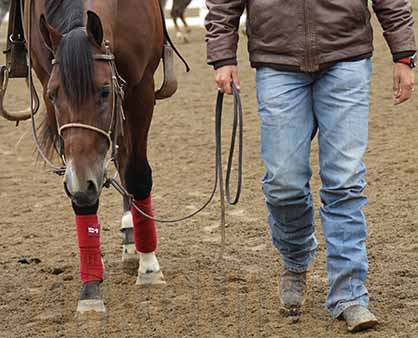Quick Tip – What You Need to Know: Equine Leg Bandaging
At some point, nearly every horse will need a leg wrap or bandage. However, an inappropriate bandage application can cause as many problems as a well-applied bandage can prevent. The key to successful bandaging begins with the proper materials and application. So, before you reach for the nearest roll of Vetrap, review some basic principles behind bandaging and wrapping legs:
1. Evaluate Need
First, it is important to evaluate what and why you are bandaging. According to the American Association of Equine Practitioners, several situations where leg bandages are beneficial to your horse include:
- Providing support for tendons and ligaments during strenuous workouts
- Preventing or reducing swelling after exercise or injury
- Protecting legs from impact
- Shielding wounds from contamination and assisting in healing1
For more severe cases or if you are in doubt, it’s always wise to consult your veterinarian when determining bandaging needs.
2. Complete it Safely
You know you need to bandage, but your horse is nervous, frightened or won’t cooperate. What do you do?
Dormosedan Gel® (detomidine hydrochloride) is a safe and effective mild standing sedative available with a prescription from your veterinarian. Having tubes of Dormosedan Gel on hand allows the horse and horse owner to experience less stress in emergency situations, and it can assist in situations such as treating an injury or bandage changes. Dormosedan Gel is an FDA-approved oral sedative that can be safely administered underneath the horse’s tongue by horse owners through the easy-to-use dosing syringe.
3. Focus on the Details
Upon determining if bandaging is necessary, it’s important to pay attention to the details. Proper technique includes using the correct materials and wrapping the leg evenly with consistent pressure.
“It is best if the leg is clean and dry prior to applying the bandage,” said Jeff Hall, DVM, senior equine technical services veterinarian at Zoetis. “Also, moderate pressure should be used while bandaging to avoid overtightening. The key is to apply the bandage firmly but not too tightly.”
Other details to take note of include:
- Keep it clean. Shavings, straw, dirt and moisture can irritate the skin and increase the risk of a wound becoming infected. Start with clean, dry materials and check the bandage frequently for damage, dirt or moisture. Use uniform pressure, as you want an even distribution of compression along the leg. Uneven tension in a bandage’s securing layers can potentially cause tendon damage.
- Avoid incorporating frayed bits of padding that contain wrinkles or bunches. These can cause pressure points under a bandage.
- Overlap layers of bandage by 50 percent to avoid having edges of the wrap material dig into the leg.
- Ensure the bandage is smooth against the horse’s leg to avoid uneven pressure.
- For safety, the person applying the bandage should avoid kneeling or sitting on the ground, and should instead crouch, ready to move out of the way if necessary. Some horses initially resent wraps on their hind legs, especially over the hocks, so it’s best to apply these while in a safe position in case the horse kicks out.
A well-applied bandage will look neat, even and finished. Ask your veterinarian to demonstrate proper techniques and practice under their supervision before doing it on your own.
If you have questions or concerns about bandaging techniques, do not hesitate to contact your veterinarian. For more information and resources, visit DormGel.com.
IMPORTANT SAFETY INFORMATION
Do not use Dormosedan Gel in horses with pre-existing atrioventricular (AV) or sinoatrial (SA) block, with severe coronary insufficiency, cerebrovascular disease, respiratory disease, or chronic renal failure. Do not use in anesthetized or sedated horses, or in conditions of shock, severe debilitation or stress due to extreme heat, cold, fatigue or high altitude. Do not use in horses intended for human consumption. Handle gel-dosing syringes with caution to avoid direct exposure to skin, eyes or mouth. See full Prescribing Information.
About Zoetis
Zoetis is the leading animal health company, dedicated to supporting its customers and their businesses. Building on more than 60 years of experience in animal health, Zoetis discovers, develops, manufactures and markets veterinary vaccines and medicines, complemented by diagnostic products, genetic tests, biodevices and a range of services. Zoetis serves veterinarians, livestock producers and people who raise and care for farm and companion animals with sales of its products in more than 100 countries. In 2016, the company generated annual revenue of $4.9 billion with approximately 9,000 employees. For more information, visit www.zoetisUS.com.
1 American Association of Equine Practitioners. Leg Bandages – Bandaging Your Horse’s Legs. 2017. https://aaep.org/horsehealth/leg-bandages-bandaging-your-horses-legs. Accessed August 7, 2017.
All trademarks are the property of Zoetis Services LLC or a related company or a licensor unless otherwise noted.
© 2017 Zoetis Services LLC. All rights reserved. GEQ-00344











